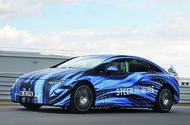How Does Steer-by-Wire Actually Work in Modern Cars?
Imagine turning your steering wheel and, instead of a physical rod connecting you to the wheels, sensors and computers translate your movement into digital signals. That’s the core of steer-by-wire technology. It removes the traditional mechanical link between the steering wheel and the road wheels, relying instead on sensors, electric actuators, and sophisticated software to control direction.
Mercedes is leading the charge in Germany, rolling out a ZF-developed steer-by-wire system. Meanwhile, Nio’s ET9 and Lexus’s upcoming RZ are also embracing this tech, and Bosch is gearing up to supply several Chinese automakers. What’s fueling this shift? Precision, flexibility, and a whole new world of design possibilities.
Why Was Steer-by-Wire Off-Limits Until Recently?
For decades, regulations required a direct mechanical connection between the steering wheel and the wheels. The thinking was simple: if electronics failed, you’d still have control. But in 2003, UNECE Regulation 79 changed the game in Europe, making steer-by-wire legal—provided manufacturers met strict safety standards.
That opened the door for innovation. Now, automakers can design cars with more freedom, but they’re also responsible for ensuring these systems are as safe—or safer—than the old-school setups.
What Happens If the Electronics Fail?
Safety is the elephant in the room. Mercedes, for example, has built in layers of redundancy. Every critical component—signal paths, power supplies, hardware actuators—has a backup. If one electronic link fails, another takes over seamlessly.
But what if the whole system goes down? Even then, cars like Mercedes’ models can use rear-axle steering and selective braking (via the electronic stability program, or ESP) to help the driver maintain control. It’s not just theory, either. Mercedes has logged over a million kilometers of bench and real-world testing to prove the system’s reliability.
How Does Steering Feel Without a Mechanical Link?
One of the quirks of steer-by-wire is the lack of natural steering feel. With no physical connection, you don’t get the usual feedback from the road. To fix this, manufacturers use software to simulate the sensation. The system calculates tire-to-road contact and feeds that information back through the steering wheel—essentially creating a virtual sense of resistance and feedback.
This isn’t a one-size-fits-all solution. Each car model gets its own calibration, fine-tuned to deliver the right balance of responsiveness and comfort. The result? A steering experience that can be tailored to different driving styles or even specific road conditions.
What Design and Practical Benefits Does Steer-by-Wire Offer?
The absence of a bulky steering column opens up a world of possibilities. Nio, for instance, touts the ability to adjust the steering wheel’s angle and feedback, making control more precise. The ET9’s system filters out over 80% of unwanted road vibrations, and the steering column can telescope in and out by 153mm—great for comfort and accessibility.
Designers can even experiment with rectangular steering wheels for a better view of the dashboard, or reduce the wheel’s rotation needed for a full lock to just 240 degrees. And here’s a fun twist: Nio is exploring a Game Mode, a nod to the Chinese market’s love of digital experiences, and the tech could eventually enable joystick steering.
Is Steer-by-Wire Ready for Everyday Drivers?
The short answer: it’s getting there, fast. With major brands investing in rigorous testing and safety redundancies, steer-by-wire is poised to become mainstream. According to a 2023 report from MarketsandMarkets, the global steer-by-wire market is projected to grow at over 8% annually through 2030, driven by demand for advanced driver-assistance systems and electric vehicles.
Drivers can expect more precise control, less vibration, and customizable steering feel. Plus, the technology paves the way for future innovations—think autonomous driving and radically new interior layouts.
The big takeaway? Steer-by-wire isn’t about perfection—it’s about smarter adjustments. Start with one change this week, and you’ll likely spot the difference by month’s end.

